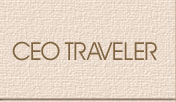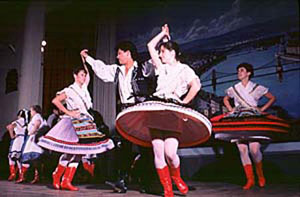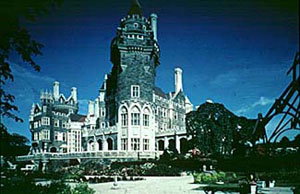 |
|
|
|
|
|
|
|
|
|
|
|
|
|
|
|
|
|
|
|
|
|
|
|
|
|
|
 |
 |
|
|
|
|
|
|
|
|
|
|
|
|

|
Toronto
City of Diversity Like all major cities Toronto prizes its image. "Clean, safe and civilized," said my guide, Judy Hammond, who moved from a small town in Ontario to the provincial capital. "At first I was reluctant about the change, but now that I live here, I have fallen in love with the place," she added. While beamingly escorting me from one neighborhood to another, Hammond further championed her adoptive home, describing it as "dynamic, growing, ethnically diverse and friendly." It was my first day ever in Toronto, a city that only recently seemed to have piqued my interest. The big metropolis of English-speaking Canada is the southernmost of the three great cities in the country’s northeast region and the only one with which I was unfamiliar. I knew the other two famous cities fairly well. Quebec, with its Old World French culture and cuisine, has always been a delicious retreat from the overly frantic pace of urban life. Montreal offers a more modern French identity, but mixed with broader European cultural influences.
From my friends who spoke positively of Toronto—in fact, two of them relocated from Manhattan—I learned that the city had developed into a great financial and industrial center, as well as an important player in the arts and culture. I was glad that I postponed a visit for as long as I had to the time when the transformation from a sleepy, dullish center to a more cosmopolitan looking one was well underway. As the taxi brought me in from the airport, I was struck by the concentration of large ultra-modern office buildings in the downtown area. Like an artist’s rendering of tomorrow, a new skyline of futuristic high rises glitters near Lake Ontario and the ferry docks servicing the Toronto Islands. The abundance of glass and aluminum and the urgency to build reminded me very much of Singapore. Large abstract steel sculptures are placed in the spaces beside the towering buildings, just as they sometimes are in New York City. As I emerged from the cab in front of my hotel, The Royal York with its sprawling 19th-century castle-like appearance, I saw that it faced Union Station, one of the terminals for VIA Rail, Canada’s national passenger train service. With Hammond’s help, I soon found that it was easy to get around. The subway system is efficient and user-friendly. Above ground I discovered streetcars on some avenues and found that taxis are cheap and plentiful. For the pedestrian, Toronto has numerous prime shopping avenues and a huge Underground Walkway called PATH, which links 1,100 stores, six hotels, five subway stops, the bus and railroad terminals and just about everything else in the downtown. Also prized in Toronto are its multiculturalism and its range of ethnic neighborhoods. Along with my guide, I hopscotched around town on foot and by cab to sample the wonderful mosaic of distinctive enclaves. I did not find Toronto as British as I had expected, but discovered that it is, above all, a genuine melting pot of which the residents are quite proud. Because of the country’s easy immigration policies, Toronto has become a mecca for ambitious people from all over the world.
A walk in a northerly direction from the harbor area along Spadina Avenue brings you past several blocks lined with furriers, through the entertainment section and to the expansive Chinatown, which is larger than the one in New York City and home to Chinese from Hong Kong, Singapore, Taiwan, Vietnam and the mainland. At King’s Noodles you can look through the window to see noodles being made. In the produce shops, jackfruit, mangosteen and durian, as well as other exotic fruits and vegetables that are staples of Asian cuisine, are sold. Greektown known as "The Danforth" because of the name of the major road that crosses the neighborhood not only features Greek cuisine, but is also the site of a lively mix of specialty shops, clubs and cafes. In 1907, only 20 Greek names appeared in the telephone directory. Today, the number has risen to more than 130,000. On summer weekends the sidewalks of Little Italy (now inhabited by Portuguese, too) are crowded with tourists. The neighborhood’s oldest Italian restaurant and outdoor patio, Cafe Diplomatico ("The Dip" to locals) attracts a nightly crowd of people watchers. Other major ethnic enclaves include Little Poland, Portugal Village, Little India and Koreatown, each with traditional restaurants, foods stores and shops specializing in goods imported from the merchants’ native countries.
Toronto, like Montreal, hosts many festivals and special happenings. Considered the city’s signature event, the International Festival Caravan now in its 32nd year and billed as a "Millennium Celebration" will take place from June 23 through July 1, 2000. To honor the city’s diversity, international pavilions, as well as theme pavilions, showcasing dance, art, music, crafts and cuisine will spread across Greater Toronto. Along with the pageantry recalling the achievements of each ethnic community during the past century, the more than 40 "international cities" pavilions will house replicas of castles, chalets, marketplaces and village squares. About 200 shows are scheduled during this mini-Expo. Canada’s largest museum, the Royal Ontario Museum, boasts a particularly extensive collection of early Chinese and Korean art. The Art Gallery of Toronto, perhaps the oldest gallery in the city, shows the works of Canadian and American artists, including that of the native peoples. It houses the world’s largest assemblage of sculptures by Henry Moore. Toronto is known for theater, music, dance and other performing arts that fill its auditoriums. Home to over 200 professional companies, it is one of the largest entertainment centers in the English-speaking world.
Casa Loma is at the top of every tourist attraction must-see list. This 98-room mansion, built in 1914 by financier and soldier Sir Henry Pellat, resembles a medieval castle. You can climb the turreted towers for a view of the city. The great hall with its 60-foot ceilings holds a pipe organ and is festooned with old Canadian flags hanging from the rafters. The living room, bedrooms, library, dining room and suites, furnished with period antiques, have a lived-in look. The military equipment used by Sir Henry’s Home Guard regiment, the Queen’s Own Rifles, is on display. The castle cost over three million dollars to build, but was lost to the taxman just 10 years later, when Sir Henry suffered financial ruin. Everything from brand names to boutiques can be found in Toronto. The centerpiece to the downtown shopping experience is the Toronto Eaton Centre. For the top of the line in fashion, stroll the Bloor-Yorkville section. Internationally known upscale chains have outposts here, as do individual shops selling the creations of local designers. Best for browsing is the Harborside Antique Centre, not too far from the ferry docks. An entire floor is covered with booths that stock quality antiques. Each one specializes in a specific type of collectable, such as old luggage, photos, Toby mugs, Art Deco furniture, majolica, cut glass, silver and Japanese kimonos. Skip the second floor to which the junk has been relegated. WHERE TO STAY When it opened in 1929, the Royal York was the largest and tallest building in the British Empire. A 19th-century edifice of grand and stylish demeanor, the hotel is part of the Canadian Pacific chain, the luxury hostelries scattered across Canada. Last year 27 properties from the Canadian Pacific portfolio merged with seven Fairmont hotels to form a new management company, Fairmont Hotels and Resorts. A five-year renovation completed in 1993 restored the premises to its former elegance. Guestrooms were refurbished, all public spaces were redone and a health club and skylit lap pool were added. The Executive Floor is particularly comfortable and has its own lounge where complimentary breakfast and snacks are served and concierge service is available. The hotel provides direct access to the Underground Walkway and its shopping arcade, as well as the subway system. The Royal York, 100 Front Street West, Toronto, Ontario M5J IE3. Tel. 800-866-5577, 416-368-2511. Rates begin at $105. www.fairmont.com Spring 2000 |
||||||||||



